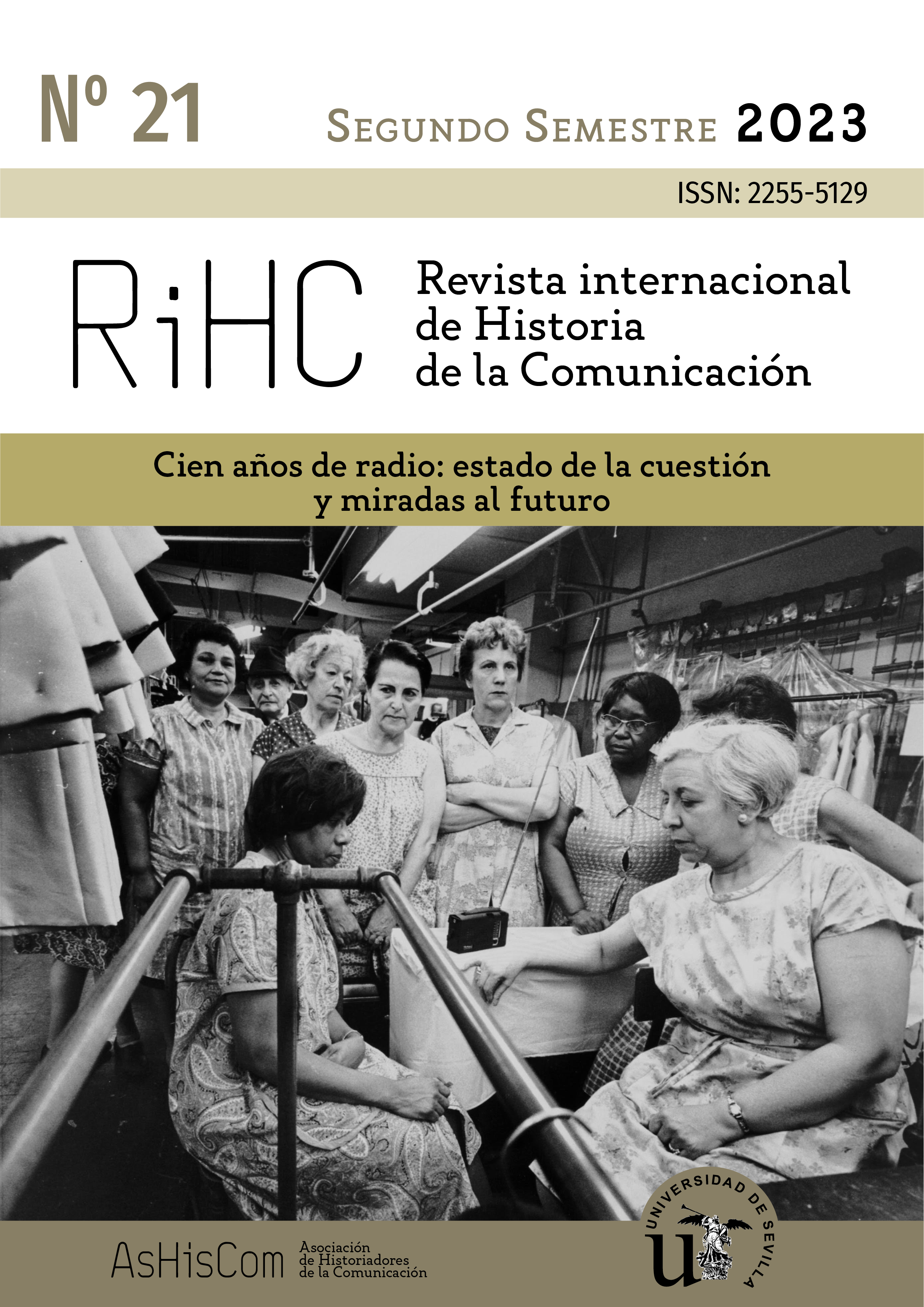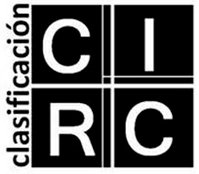Radio Luxembourg and Europe n°1 in the 60s: transnational and intermedial actors by excellence
DOI:
https://doi.org/10.12795/RIHC.2023.i21.05Keywords:
Radio Luxembourg, Europe n°1, Transnational history, Intermediality, Commercial radiosAbstract
Commercial radio stations, like Radio Luxembourg and Europe n°1, were highly popular media in Western Europe in the 1960s, which notably broadcasted in French, English, and German. However, their study has not received as much attention as their public counterpart. Following a trend pushing to bring them back into the centre of attention, this contribution reveals the rich potential of commercial radio stations for historical literature and radio studies and acts as a plea to further their study. As commercial entities, these radio stations do not have to share their archives, which are often in multiple sites and languages, making their study difficult. Despite these challenges, writing their history offers many opportunities for radio scholars. First, commercial stations are based in peripheral regions of large markets such as France, in order to avoid State monopoly on broadcasting, making them key transnational actors. They are not only ideal subjects to conduct radio history across borders; they are also particularly relevant when it comes to cross-media studies. Indeed, stations like Radio Luxembourg and Europe n°1 strongly relied on other media to support their overall commercial venture. Therefore, this contribution will study the potential of such stations to enrich radio history by including perspectives from transnational and transmedial lenses.
Downloads
References
ANNA, J. (2018): Welle der Konsumgesellschaft: Radio Luxembourg in Frankreich, 1945-1975, Göttingen, Wallstein.
ANTOINE, F. (2016): Analyser la radio. Méthodes et mises en pratique, Louvain-la-Neuve, De Boeck.
BADENOCH, A.; FICKERS, A. y HENRICH-FRANKE, C. (eds) (2013): Airy Curtains in the European Ether: Broadcasting and the Cold War, Baden-Baden, Nomos.
BECCARELLI, M. (2021): Micros de nuit. Histoire de la radio nocturne en France, 1954-2012, Rennes, Presses Universitaires de Rennes.
BERG, K. (2021): Grenzenlose Unterhaltung: Radio Luxemburg in der Bundesrepublik 1957-1980, Göttingen: Wallstein.
BERG, K. y JEHLE, A. (2916): “Through the Air to Anywhere: Radio Luxembourg - A Transnational Broadcasting Station?”, en Classen, C. (editor), Transnational Broadcasting in Europe 1945-1990, Frankfurt am Main, Peter Lang, pp. 23-44.
BLANDIN, C. (ed.) (2018): Manuel d’analyse de la presse magazine, Malakoff, Armand Colin.
BULL, M. (2004): “Sound, Proximity, and Distance in Western Experience”, en Erlmann, V. (editor), Hearing Cultures. Essays on Sound, Listening and Modernity, Oxford, Berg, pp. 173-190.
CHION, M. (2012): “100 concepts pour penser et décrire le cinéma sonore”, disponible en http://michelchion.com/texts [recuperado el 20 de agosto de 2023].
COHEN, D. R.; COYLE, M y LEWTY, J. (eds.) (2009): Broadcasting Modernism, Gainesville, University Press of Florida.
CRISELL, A. (1994): Understanding Radio, London, Routledge.
CRONQVIST, M. y HILGERT. C (2017): “Entangled Media Histories. The Value of Transnational and Transmedial Approaches in Media Historiography” en Media History, 23:1, pp. 130-141.
CROOK, T. (2012): The Sound Handbook, Abingdon, Routledge.
DAKHLIA, J. (2018): “Propriétés et fonctions de la presse magazine”, en Blandin, C. (editor), Manuel d’analyse de la presse magazine, Malakoff, Armand Colin, pp. 51-65.
FICKERS, A. (2009): “Radio” en AKIRA, I. y SAUNIERS, J. (editors), Palgrave Dictionary of Transnational History, Basingtoke: Palgrave Macmillan, pp. 870-873.
FÖLLMER, G. y BADENOCH, A. (eds.) (2018): Transnationalizing Radio Research: New approaches to an old medium, Bielefeld, Transcript.
GAUDREAULT, A. (1999): Du littéraire au filmique: Système du récit, Malakoff, Armand Colin.
GOODALE, G. (2011): Sonic Persuasion: Reading Sound in the Recorded Age, Urbana, University of Illinois Press.
HILMES, M. (2012): “Radio and the imagined community”, en STERNE, J. (editor), The Sound Studies Reader, Abingdon-on-Thames, Routledge, pp. 351-362.
IRIYE, A. y SAUNIER, J. (eds.) (2009): Palgrave Dictionary of Transnational History, Basingtoke, Palgrave Macmillan.
JENSEN, K.B. (2016): “Intermediality”, en Jensen, K. B. et al (eds.), The International Encyclopedia of Communication Theory and Philosophy, Chichester, John Wiley & Sons, pp. 972-982.
LACEY, K. (2018): “Up in the air? The matter of radio studies” en The Radio Journal: International Studies in Broadcast & Audio Media, 16:2, pp. 109-126.
LEGAY, R. (2020): Commercial Radio Stations and their Dispositif. Transnational and Intermedial Perspectives on Radio Luxembourg and Europe n°1 in the Long Sixties, Tesis Doctoral, University of Luxembourg.
- (2023): “‘Studying 1960s commercial radio”, en McDonald, K. y Chingell, H. (eds.), Bloomsbury Handbook of Radio, Londres, Bloomsbury, pp. 367-382.
LORIOU, C. (2018): “Faire de l’histoire, un casque sur les oreilles: le goût de l’archive radiophonique”, en Clavert, F. y Muller, C. (editors), Le Goût de l’archive à l’ère numérique, disponible en https://gout-numerique.net/ [recuperado el 20 de agosto de 2023].
MARTINEZ ALFARO, M. J. (1996): “Intertextuality: Origins and Developments of the Concept”, en Atlantis, 18:1-2, pp. 268-285.
MCDONALD, K. (2023): “The Radio Phone-in and the Suicide Caller”, en McDonald, K. y Chignell, H. (editors), Bloomsbury Handbook of Radio, Londres, Bloomsbury, pp. 190-207.
MÜLLER, J. E. (2000): “L’intermédialité, une nouvelle approche interdisciplinaire: perspectives théoriques et pratiques à l’exemple de la vision de la television”, en Cinémas, 10:2-3, pp. 105-134.
MURPHY, K. (2016): Behind the Wireless: A History of Early Women at the BBC, Londres, Palgrave Macmillan.
NICHOLAS, S. (2012): “Media History or Media Histories? Re-addressing the history of mass-media in inter-war Britain”, en Media History, 18:3-4, pp. 379-394.
OTA, N. (2019): “The Voiceful Voiceless: Rethinking the Inclusion of the Public Voice in Radio Interview Programs in Occupied Japan”, en Historical Journal of Film, Radio and Television, 39:3, pp. 584-601.
PÉREZ MARTÍNEZ, J. E. (2020): Radio y mujer (España, 1960-1975): En las Ondas de Radio Nacional, Madrid, Abada Editores.
RAJEWSKI, I. (2005): “Intermediality, Intertextuality, and Remediation: A Literary Perspective on Intermediality”, en Intermédialités/Intermediality, 6 (2005): 43-64.
RIKITIANSKAIA, M. (2018): “A Transnational Approach to Radio Amateurism in the 1910s”, en Föllmer, G. y Badenoch, A. (editores), Transnationalizing Radio Research: New Approaches to an Old Medium, Bielefeld, Transcript, pp. 133-140.
VAN REMOORTEL, M.; EWINS, K.; KOFFEMAN. M. y PHILPOTTS, M. (2016): “Joining Forces: European Periodical Studies as a New Research Field”, en Journal of European Periodical Studies, 1, pp. 1-3.
Downloads
Published
How to Cite
Issue
Section
License
Copyright (c) 2023 RIHC. Revista Internacional de Historia de la Comunicación

This work is licensed under a Creative Commons Attribution-NonCommercial-ShareAlike 4.0 International License.
RiHC. Revista internacional de Historia de la Comunicación is an open access publication, offering its content under the principle that making research available to the public free of charge contributes to the greater exchange of global knowledge.
RiHC. Revista internacional de Historia de la Comunicación adheres to the various initiatives that promote access to knowledge. All content is therefore free of charge and is published under the Creative Commons Attribution-NonCommercial-ShareAlike 4.0 International license.
By virtue of this, the authors who publish in this journal accept the following conditions:
- Open access content may be freely shared (that is, copied and redistributed in any medium or format) and adapted (remixed, transformed and built upon).
- Attribution: The user of the content must give appropriate credit, provide a link to the license, and indicate if changes were made. This may be done in any reasonable manner, but not in any way that suggests the licensor endorses the user or their use.
- Non Commercial: The content may not be used for any commercial purpose.
- Share Alike: If the content is remixed, transformed or built upon, it must be distributed under the same licence as the original.
- No additional restrictions: No legal terms or technological measures may be applied that legally restrict others from doing anything the licence permits.













